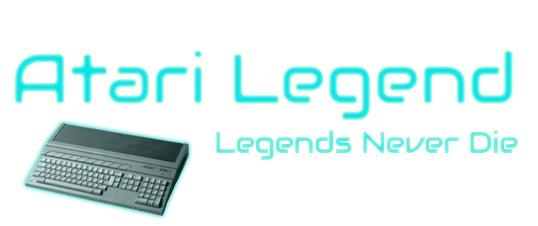

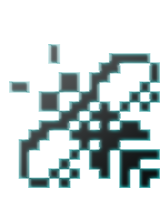





Four years ago, Thomas Ilg released a new version of his first PD game Laserball. Originally released in 1990, this new version was available complete in cardboard box! And thus making one of his ambitious dreams come true. That wasn't the last we would hear from Thomas. 2 years ago he teamed up with Alan Tomkins and created the crazy Anarcho Ride! Time to talk to this very interesting person, don't you think?
There is currently no profile available in our database
1) Introduction
2) His own IMDB page
3) Geek talk
4) Atari ST forever
5) Laserball
6) More lasers and balls!
7) Going physical
8) Anarchy rules
9) A racing game ... or not?
10) Alan joins the fun
11) A bigger team
12) Melanie
13) Professionals
14) The Anarcho Ride is not over ... yet?
15) Future goodies ... maybe
16) Do the right thing
17) The ST scene
18) Too slow for gaming
19) Proud to be...
20) Meet & Greet
21) The A-Team reference
22) Wisdom
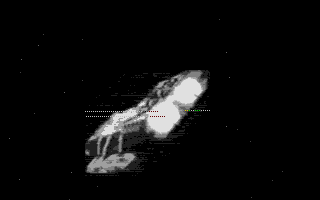
The original Laserball contained images digitized from TV. 'There was a lot of copyright infringement', according to Thomas. Although it is hard to see what is displayed in this digital image.
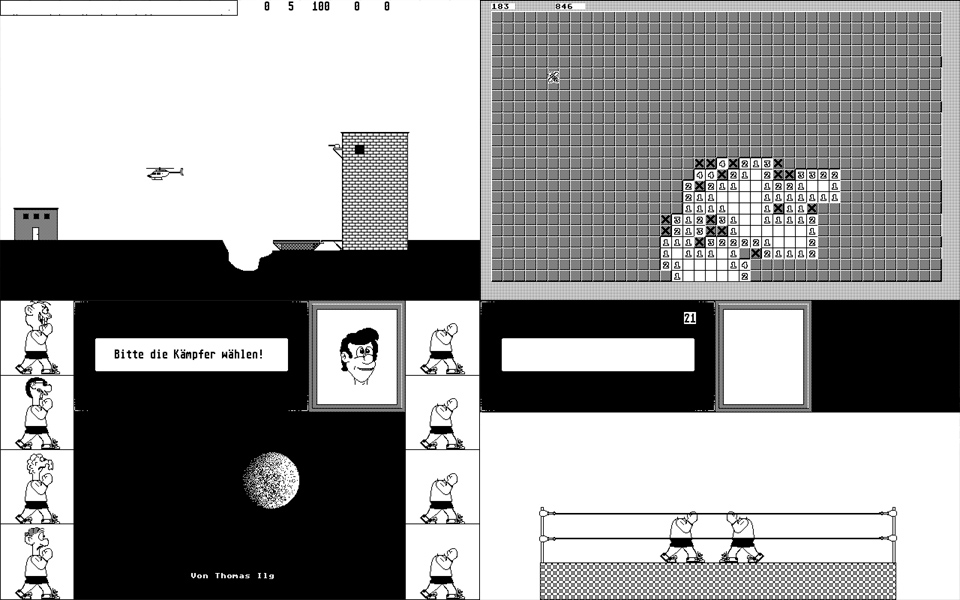
Some screenshot of Thomas' unfinished work. A selection of mono games. I immediately see a Choplifter clone.
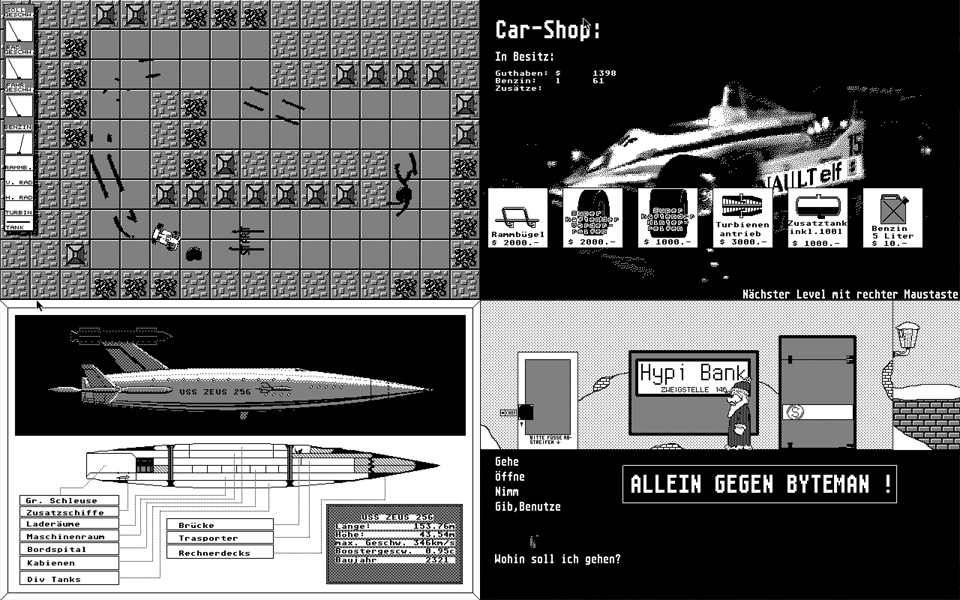
More unreleased mono games. A lot of attention to detail went into the graphics of these screens. The Top Down racer you see was almost done (apart from openent AI) and was called 'Cash Racer'.
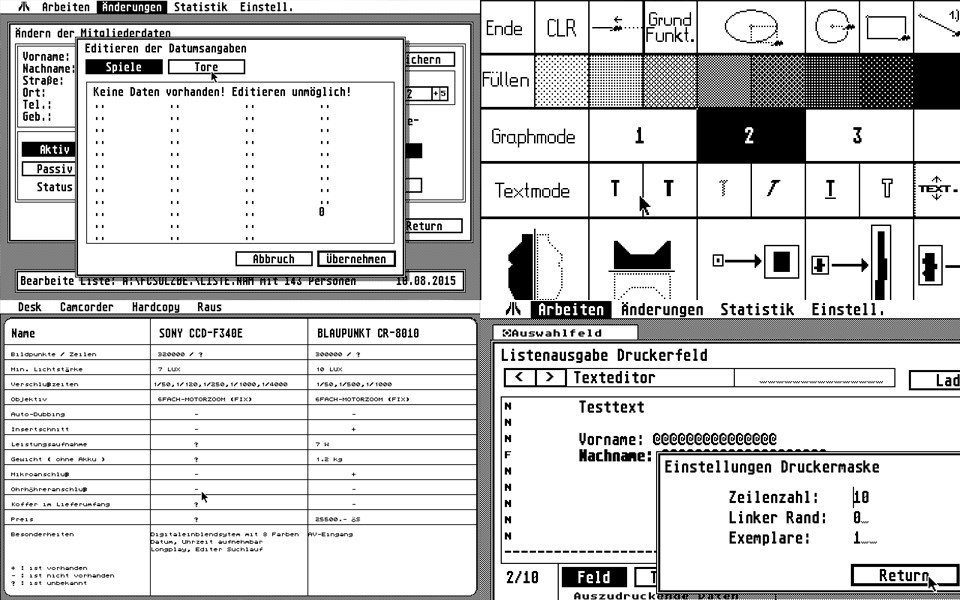
Thomas also made some utilities on the ST. "The most serious stuff I made was a management software for a local Football Club, that was actually in use for some time. Hey! I invented the 'tab' logic for that… 5-10 years before it came to Windows ;-)"
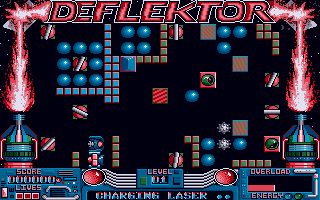
While most people compare Laserball to the classic Gremlin game Deflektor, Thomas only ever saw this game after the release of Laserball 2015!
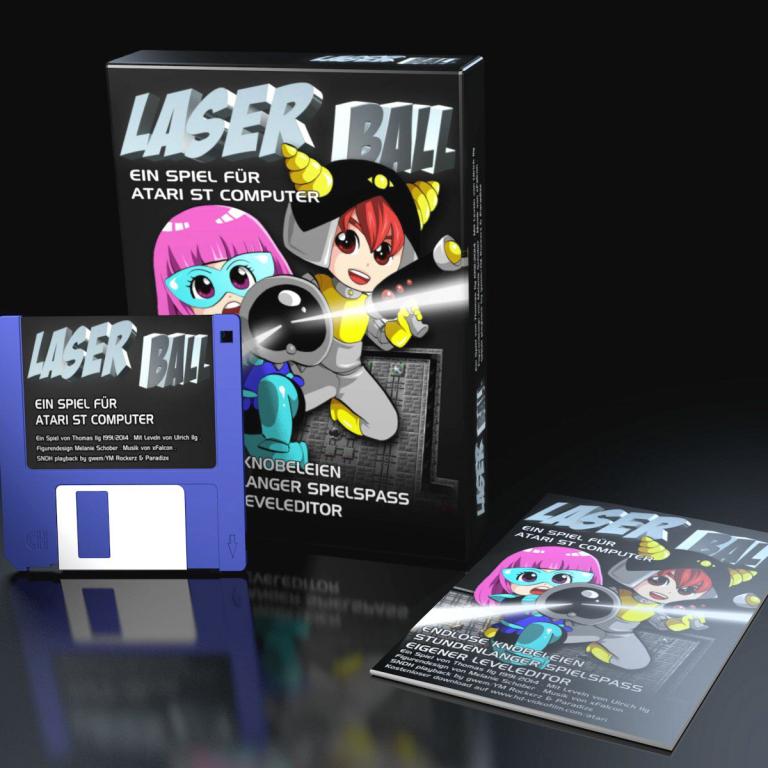
The beautiful physical release of Laserball. For those who missed it, if 15 people sign in, a new batch is created. Come on people!

The promotion campaign for Anarcho Ride was so professionally made. This is one of the many posters designed by Melanie Schober.
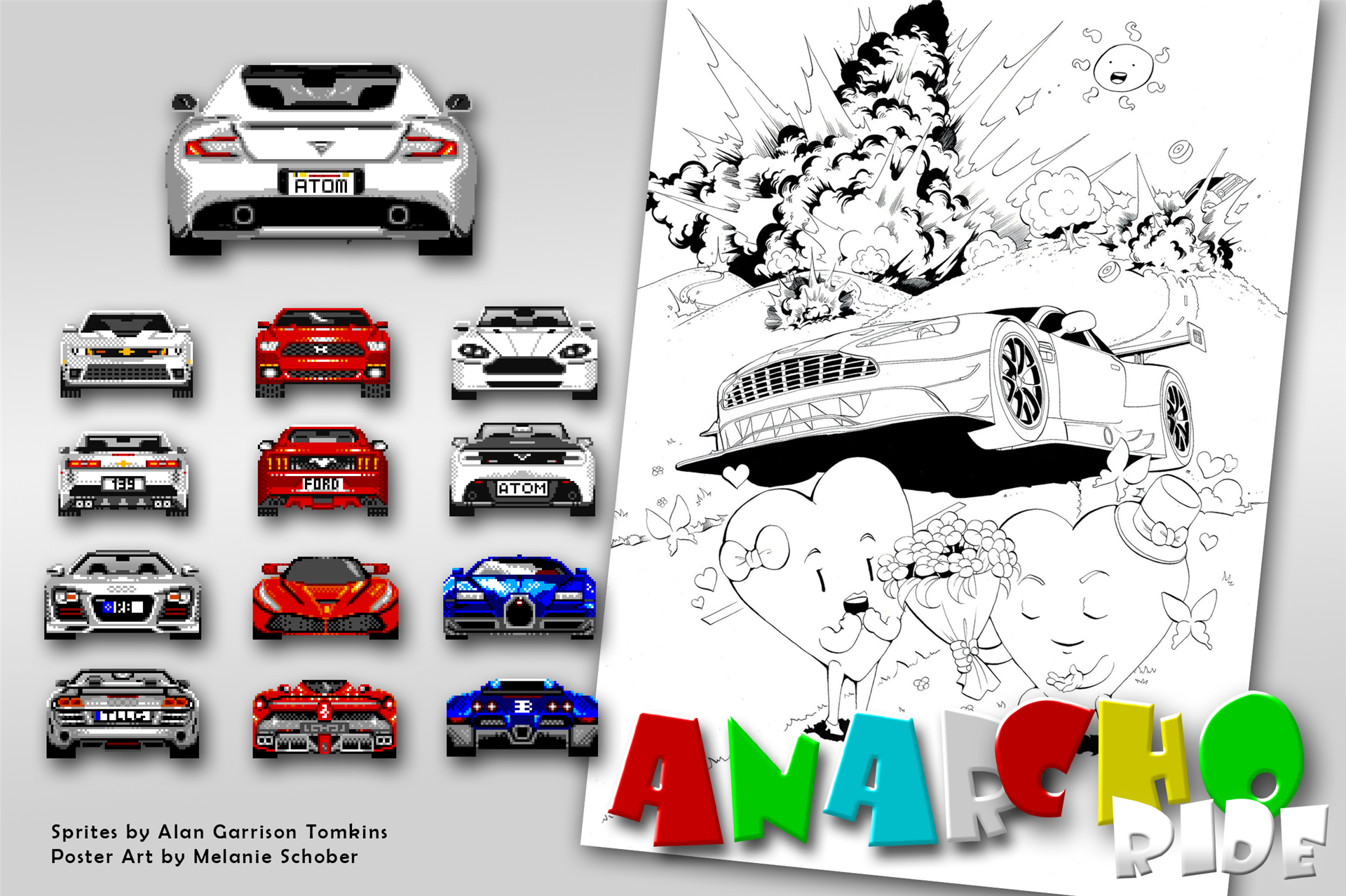
Some artwork by Alan Tomkins and the original poster sketch by Melanie Schober for the game Anarcho Ride.
1) Hello Thomas, thanks for joining us. Let's start with the usual, introduce yourself to the public
My Name is Thomas, I am 45 years old and in my daily life I am a film editor. Today I have little to nothing to do with coding – apart from my excursions to the ATARI.
2) Sounds like an amazing job. How did you start in the world of film? And have you perhaps worked on something we might know?
Some 20 years ago I started as a set-assistant in Switzerland. I became a camera operator. But I like storytelling and I found that I can do it best in film-editing.
It is unlikely you know my work. Obviously I have done countless commercial work. But also on the feature and documentary side I have built up a nice portfolio. If you have stumbled across it depends on where you live. This is my IMDB page.
3) Thomas, we are all geeks here. You must be a movie buff. What is your favorite movie/director?
I love innovative storytelling. If I should pick a name, I have to say Christopher Nolan – the true master of this art.
4) Ok, I'm drifting off here. Tell us about your history with computers. What was the first computer you owned and where does the Atari ST fit in exactly?
The ATARI ST was actually my first computer and it stayed with me for years. I was about 15 years old when I got it with a monochrome monitor. And for whatever reason I started to program on it. I built up my knowledge from books and magazines. And I found my language: GFA Basic - the only language I have ever mastered - on the only system I have truely done coding. I do not consider myself to be a good coder, as I have never gotten my brain around the deeper technical backgrounds or anything more serious than BASIC, including modern coding.
5) In 1990 you released your first Atari ST game called Laserball. Was this the first game you ever programmed?
Laserball had a simple premise that I programmed after playing Atomix and Oxyd. It was by far not the first game I programmed. But it might have been the first one that has not been a direct copy of an existing idea, but instead built something new on top of two influencing concepts. And soon I realized that the idea was fun to play around: my brother (13 years old at the time) designed levels, to challenge me and vice versa. I polished it a bit and sent it to a Public Domain Magazine. And I was so proud when I saw it getting officially listed.
Fun fact: it was only when I started to republish the game in 2014 that I was made aware of the game Deflector by people pointing out the striking similarities – but they are just a coincidence.
Most of the things before Laserball are unfinished fragments of Ideas – usually direct 'remakes' of stuff that I saw at the time. But if you look at the screenshots, you will see, that I always spent a great amount of effort in the graphical presentation…
There is one thing I have done later for my filming needs: A specialized teleprompter software that I have created using the good old MACROMEDIA Director (for people who might remember this tool). I would not consider this real coding, but the result is still in use today. Just recently I made a demo video and a homepage.
6) From out of nowhere, in 2014 you returned to your roots and started bug fixing Laserball again. What was it that reignited your interests in Atari ST game making?
Personally I rediscovered the game in 2009. And I was shocked! ![]() In our attempt to make the game 'not too easy' my brother and I created levels that nobody could master, especially without a proper tutorial. There was no 'community feedback' in 1990, no 'correcting factor', nobody that told us 'Hey, your game is much too hard!'. In addition to that, there was a lot of copyright infringement: I had simply digitized some images from TV. Something my 17 year old self had never given any second thought.
In our attempt to make the game 'not too easy' my brother and I created levels that nobody could master, especially without a proper tutorial. There was no 'community feedback' in 1990, no 'correcting factor', nobody that told us 'Hey, your game is much too hard!'. In addition to that, there was a lot of copyright infringement: I had simply digitized some images from TV. Something my 17 year old self had never given any second thought.
It took me another 5 years to actually open the code… and I got caught… ![]()
First I made it more accessible by adding tutorials and entry levels… and on the way, I corrected some major issues within the original code structure. That again made it possible to make the game bigger and better than it ever was. And to round it all up, I got rid of ALL the copyrighted images and added music with the help from the amazing Melanie Schober and xFalcon.
If you ask: 'But why???' … maybe to fulfil the dream of my 17 year old self of making a proper videogame.
7) For Laserball 2015 you went all the way, even creating a boxed version of the game. Was this a hard task and why did you decide to do this?
Having my game put in a box, was also the dream of my 17 year old self. So I decided to do it mostly for me… and it became true. It was not hard, but it took some time to have the right companies in place to do the job.
8) Just when we thought it was all over, you came up with the completely bonkers game Anarcho Ride. Can you tell a bit about the history of this game?
The pure core of Anarcho Ride also goes back to early 1990: I was fascinated by driving games and tortured my brain on how to achieve a pseudo-3D effect like in so many driving games of that time. So without any knowledge of how 'real' games have done it, I found my own solution. But I got some 2 frames per second and soon lost interest.
Jumping forward to 2015 I stumbled over this code fragment of a 'moving street', and start to optimize it. (The first seconds of the 'Evolutions' video shows what was there, when I rediscovered the code-fragment in 2015)
And it still surprises me that my GFA Basic gameloop can keep up with the frame-rate of most commercial ST driving games – just using 'every day household' BASIC commands.
9) Anarcho was something completely different compared to Laserball. What inspired you to create these games in the first place?
When I rediscovered it, I realized that there was kind of a potential for a game, but not in a sense that could compete with the classics of the genre. So I decided to turn the idea upside down: a caricature of a driving game, where you cannot crash your car. This opened the door for a lot of crude humour and even political satire. I loved to combine the candy style graphics with crazy music and completely over the top cartoon violence.
10) The graphics were done by a big guy in the world of gaming, Alan Tomkins. How did you meet him and was he fun to work with?
Working with Alan was amazing! He simply answered a forum-request for a pixel artist who would like to design some cars and more for my game (I had a demo video with coder-graphics to show the basic idea) I was amazed when I found out who he was.
Alan brings working knowledge to the table, that modern designers do not have any more: the ability to think in limited resources. 16 colours, 320x200. That’s it! And he is able to design stunning stuff within this limited framework.
From my side I gave him absolute creative freedom. I had a pipeline set up to bring any sprite he designed from a PC file into the game within 15 minutes.
And the same goes with the amazing music by XFalcon.
Background Notice: Anarcho Ride employs a tool-set of additional software in its backyard, that makes it possible to be as modular as it is, running from floppy or hard drive, with multiple expansion disks, music, graphics,… and its own script-language to define levels and quests. There is even a white book for graphics. Anyone who wants a glimpse what is going on under the hood, I recommend to go to the 'System Setup' and make a 'Dump Console to file'... and read that file ![]()
11) Apart from Alan, Anarcho Ride was created by a bigger team, judging by the credits. Did you ever meet these people in real life? How did it all come together?
Actually aside from xFalcon and Alan Tomkins, I do not know the others. But I have used several openly available tools and routines to make the game run (better)… like the music and DMA sound playback, file compression and so on. And obviously I wanted to credit the creators accordingly. These are also the only elements in the game that are not coded in GFA Basic.
Speaking of GFA Basic: A very important role was played by Lonny Pursell. He holds all the knowledge available on GFA Basic and he helped me out with whatever question I had. He was even so kind to create a dedicated compiler library, that improved the frame rate of the game by eliminating some automated GFA-Basic background stuff. Therefore I had to take care of these aspects manually in my code, but the gameloop runs quicker.
A service like this would have been unthinkable in 1990!
12) Tell us about Melanie Schober? She has delivered the art on all your products.
I know Melanie Schober from my 'real life' job. I have worked with her on some commercial films, and she is a true professional when it comes to Manga-style artwork. Professional not only in the sense of her designs, but also in the way how she delivers her stuff on a technical side. That gives me the possibility to use and re-use her designs in the various media as you see it today, with very little technical effort.
13) Your work just oozes quality. Everything is SO professionally done, the promotion using YouTube videos and the websites. How do you do it? Do you perhaps do these kinds of things in real life?
I am a professional in film editing and therefore storytelling, with a strong background in marketing. So whatever I do, it has to stand up to the scrutiny of my own standards. I do things by myself if I know how to do them, or hire professionals if I know what I need to be done. All in a very limited fashion, because this is a just for fun – but never the less professional.
And storytelling wise, you see glimpse of it in all the Anarcho Ride stuff: The humour… the wording… I try to keep it as consistent as possible.
14) Why isn't there a boxed version of Anarcho Ride? I would love to add it to my collection?
Simple answer: too complicated. Anarcho Ride would need four double density floppy disks. Getting these today and manually loading them with content is just too much. But I had a box designed and physically test printed. And I even might have a manual designed soon. So let's see…
15) Will the box design and manual for Anarcho perhaps be released for download? Or for sale? What about floppy labels? ;-)
There is nothing ready to go yet. But something like this is possible maybe in the future.
16) Are you planning more cool stuff on the Atari ST? Did the release of both games satisfy your creative needs?
It might sound odd, but there are no plans and there have never been plans on anything. These games and ideas come with the flow… right now I am fully satisfied… but you never know. Only one thing is for sure: if I do something, I want do it right ![]()
17) What do you think of the Atari ST scene of today?
It was amazing to have feedback on the games. It feels so great to see a YouTube video popping up with someone playing my game, or read a review. It is a more personal feeling than seeing some of my film-edit work in TV or Cinema.
It is a bit sad, that the Atari community is not as big as the C64 or Amiga ones.
18) Are you a gamer? If so, what is your all time favourite game? What are you currently playing?
Actually: No. I was never a gamer. I am too slow for anything… so Anarcho Ride is the perfect game for me! I cannot die ![]()
In my ST days I used to like point and click adventures. Like Indiana Jones or Zak McKracken. They were not so stressful ![]()
19) Was there something that made you proud being an ST owner? Why did you choose this machine over the competition?
Actually it was mostly my parents decision. They did not like to have me buy a 'gaming computer' (and so they succeeded ![]() ). However, in those years I always envied my friends who owned an AMIGA… although I would NEVER have admitted that back in the day ;-)
). However, in those years I always envied my friends who owned an AMIGA… although I would NEVER have admitted that back in the day ;-)
20) Is there anybody in particular you would like to meet in person and have a beer with?
It would be great to meet the core team of Anarcho Ride once in person! The only person I have ever met in real life was Melanie Schober.
21) You call yourself Mister T. Sometimes it is Simoncam. What is that all about? :-)
Simoncam was just a random name I came up with years ago… no particular meaning. And Mister T. was used only for the fictional (hopefully funny) biographies of the Anarcho Ride core group.
22) Any words of wisdom to end this conversation?
Hmmmm….
And on that bombshell we are ending this interview. Thanks a lot for taking the time to answer some of our questions Thomas. The games you have created in the past 4 years have brought a lot of enjoyment and we want to thank you for that!
And Anarcho is the craziest thing you can get on your ST, which is simply great. I think it is safe to say you brought a smile to many faces ;-)
For more info of both the games by Thomas, check out their official websites :
- Laserball 2015
- Anarcho Ride
Please log in to add your own comment to this interview
August 5, 2025 by grams88
Martin Brownlow is a living legend. Best known among ST fans for creating the beloved PD/shareware classics Grav and Grav 2, his games are still cherished by many to this day. From a young age, Martin knew he wanted to make games for a living...and he made that dream a reality. In fact, he’s still doing it today. Discover the full story and much more in this exciting new interview.
October 4, 2024 by grams88
Stacey Jamieson began his career at DMA Design, working on titles such as Oh No! More Lemmings, Walker, GTA and others. Over the years, he moved on to Electronic Arts (EA), where he contributed to major games like the Star Wars Battlefront series, Mass Effect, and Need for Speed. Today, he is the co-founder of Expression Games, where he continues to pursue his passion for game development. What an exciting career!
July 29, 2024 by grams88
Who doesn't love a good underdog story? Chris Sharp is a noteworthy apprentice of the renowned François Lionet, as he mastered the art of coding with the almighty STOS Basic. Chris crafted a few games for our cherished ST, including fan favourites like Magic Tomb and the Freaked Out series. Intrigued? Dive into our interview to revisit the era when game development could still be a solo endeavour.
July 16, 2024 by grams88
When Sega released its Master System, it came bundled with the game Alex Kid. To this day the game remains very popular, loved by many. One of those people is Terry Lloyd. More so, Alex Kid was the main inspiration for the Atari ST platform classic Axel's Magic Hammer. But that is just one of his many accomplishments. Terry has been around the block. Working as an artist and game designer at the beginning of the 80's for Gremlin Graphics, he then moved on to Core Design, which he helped get off the ground. During the 90's he contributed to founding the company Malibu Interactive. On the Atari ST, Terry's resumé include Dynamite Dux, Car-Vup, Rick Dangerous 1 & 2, Torvak the Warrior, WarZone and many more. Read all about this veteran of the games industry in this exciting interview.
April 18, 2024 by grams88
It doesn't always have to be about computers, coding and graphics. Adrian Powell, the artist behind the original Lemmings game, crafted all its artwork, including box art and promotional materials. His passion for painting lemmings has persisted over time and he is still painting lemmings to this day. Powell's work remains influential and has helped selling millions of copies of this classic (ST) game.
Currently 0 registered users online
In the past 24h there were 2 registered users online